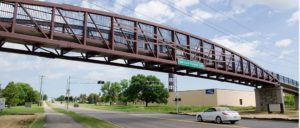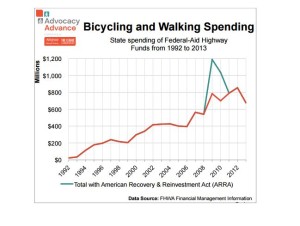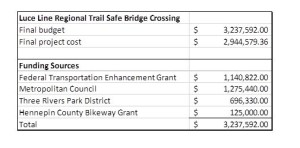
In anticipation of a special legislative session and passage of a Legacy funds bill, Alpha News is taking a look at one of the past projects funded by the constitutionally-mandated sales tax.
The Luce Line safe crossing project funded a 930 foot bridge for bicyclists and pedestrians over Xenium Lane in Plymouth and was completed last year. The projected cost was $2.5 million, but it went over budget, costing the taxpayers $2.94 million by the time it was completed per numbers from Three Rivers Park District.
The Met Council, via Legacy funds, paid for one-third of the project based on the agency’s desire to “promote exercise and reduce reliance on cars.” Another third of the funding came from a federal government transportation grant. In 2012, Congress passed “Moving Ahead for Progress in the 21st century” (MAP-21) which made monies available for projects like the Luce Line trail bridge.
Per the Advocacy Alliance for Biking and Walking , federal-aid highway funding for bike paths has dramatically increased over the last twenty years. Per the Wall Street Journal, federal highway fund spending on non-highway projects has increased by nearly 40% since 2008.
The Met Council and Three Rivers Park District recently outlined aggressive goals in the “Hennepin County 2040 Bicycle Transportation Plan” to complete an average of 20 new miles of bike paths every year and have a bikeway within 1/2 mile of 90% of homes in Hennepin County. The plan also calls for reducing per capita vehicle miles of travel 20% from 2000 levels by 2040 and for reducing the “gender gap” for bicycle commuters.
While Minnesota and federal taxpayers fund projects like the Luce Line trail crossing, the Met Council report defined an issue that many Minnesota drivers observe: the most enthusiastic cyclists want to use the roadways, not the trails. Continued funding of protected bike lanes as well as dedicated bike trails is part of the Met Council’s plan.
Minneapolis and its suburbs received $28 million in federal funding for bike paths and infrastructure back in 2005, which was administered by the Transit for Livable Communities. Per the Met Council, 12.000 people in Hennepin County commuted via bike to work in 2012, they seek to quadruple that number by 2040.
With multiple tax-funded sources it’s important for citizens to keep an eye on budgets and hold elected officials accountable for the ongoing spending on lanes, trails, and bike bridges.






